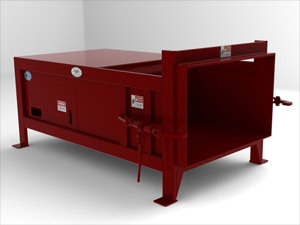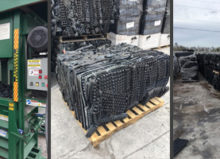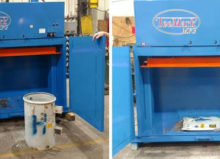What is a Stationary Compactor?
 What is a Stationary Compactor?
What is a Stationary Compactor?
Industrial or Commercial Stationary Trash Compactors are suitable for dry waste or cardboard – they are not liquid tight. This type of compactor can be used for solid waste or recyclable materials.
Stationary compactors need to be anchored to the ground at the job site, so they are not easy to move once installed. This is done to minimize vibration and provide the compactor with a solid anchor. This type of compactor is used when there are large volumes of dry, compactable materials being generated and there is not a space limitation issue on-site. The detachable receiving container is hauled to a landfill via a roll off truck. The Stationary Compactor can be fed through a wall or with an open or enclosed hopper.
Frequently asked Questions
Who would benefit from a Stationary Waste Compactor?
Waste Haulers, Home Supply Chains, Apartment Buildings, Clothing and Merchandise Chains, Distribution Warehouses, College Campuses, Government Institutions, Offices, Department Stores, Heavy Industrial Plants, Transfer Stations, Hospitals, Retail Stores and Manufacturing Plants.
Benefits of a Stationary Trash Compactor
- Cost Reduction – They save money by reducing the number of pickups
- Cleanliness – They prevent waste overflow
- Discourage Scavenging – They keep “dumpster divers” out
- Prevent Unauthorized Dumping – They keep dumpers out
- Reduce Rodent, Insect and Odor Problems
How much do Industrial Stationary Compactors cost?
They average between $11,450 to $165,000
What material can you compact in a Commercial Stationary Compactor?
Cardboard, Mixed Paper, Plastic, Textiles, Mixed Waste and Municipal Waste
What Size Compaction Chambers are available?
Charge Chamber or Compaction Chambers come in 1 yard to 12-yard capacity
What Size Receiving Can or Containers are available?
Receiving Can or Containers come in 30-yard, 40-yard, or 45-yard capacity
How much footprint does a Stationary Compactor need?
Enough space must exist for the users to bring refuse to the machine, for the machine and container to be adequately serviced and accessed and for the roll off truck to maneuver into position to pick up the container.
- A minimum of 2 feet must be allowed between the compactor / container and any building or wall to permit accessibility of operators, haulers and service technicians.
- Roll off truck must have a “clear approach” of 45 to 60 feet depending on the type of truck being used.
- Roll off truck must have 24’ of overhead clearance to pick up the container.
The clearances given are minimums. Your installation may require greater clearances depending on the site and the hauling equipment that will be used.
How much does a Stationary Compactor weigh?
A stationary compactor can weigh between 4,100 to 35,000 lbs. depending on the model
How does a Commercial Stationary Waste Compactor ship?
On a flatbed truck
How do you unload the Industrial Stationary Compactor from the truck?
A fork-lift is the most used machine for unloading a vertical baler from the shipping truck. The lifting equipment must be designed for lifting the weight of the compactor.
Installation & Commissioning considerations for a Stationary Trash Compactor
CONCRETE PAD
- Preferred dimensions of the concrete pad are 10 ft. wide and a length of 36 ft. It should be level and of minimum 3000 PSI concrete reinforced: 6 in. thick. It is preferred that the concrete pad be flush with the surrounding ground level.
- To provide accessibility, the concrete pad should be positioned to allow 2 ft, 4 in between the machine and the building wall if installed parallel with a building. Allow a minimum of 45 ft of clear space from the end of the pad for a container handling vehicle.
Note: The clearances given are minimums. Your installation may require greater clearances depending on the site and the hauling equipment that will be used.
POSITIONING
Position the compactor so that enough room is available for proper and safe operation. The compactor should be placed no less than 28 inches from any structure.
ANCHORING
The compactor should be anchored to the pad with anchor bolts (minimum 3/4” x 5”). To allow for construction variances, the holes should be drilled after locating the compactor in the desired position.
ELECTRICAL & HYDRAULIC INSTALLATION
A lockable fused disconnect switch (customer furnished) must be installed and be within sight of the compactor motor control panel location, not to exceed 50’ from the compactor. This fused disconnect switch should be sized in accordance with the compactor.
GROUNDING INSTRUCTIONS
This appliance must be connected to a grounded, metal, permanent wiring system or an equipment-grounding conductor must be run with the circuit conductors and connected to the equipment-grounded terminal or lead on the appliance. A qualified electrician should be consulted if there is any doubt as to whether an outlet box is properly grounded.
ELECTRICAL CONNECTIONS
- Run power lines, between fused disconnect switch (customer furnished) and compactor’s motor control panel, in accordance with local electrical codes, using knockouts in bottom of motor control panel.
- Check voltage at fused disconnect to be certain it is the same as is shown on compactor. If voltage is correct, put fused dis-connect switch in “ON” position.
- Check motor wiring, voltage and motor rotation.
- Check motor starter, thermal overload selector and voltage.
START-UP INSTRUCTIONS
- With the ram fully retracted, check to be sure the oil reservoir is full on the sight gauge. (Refer to the Maintenance Section for hydraulic oil recommendations). The hydraulic system pressure has been factory set and the entire unit has been operated prior to shipment.
- CAUTION: MAKE SURE PERSONS AND MATERIAL ARE CLEAR OF CHARGE BOX AREA.
- Depress the start button and check the pump for proper rotation. CAUTION: If pump rotates backward, stop immediately. The pump will be damaged if it is operated in reverse even for short periods. Reversing any two incoming power lines will change the motor/pump rotation.
- Make sure that the operators are trained in the proper use of this equipment.
How does a Stationary Compactor work?
Standard Operation
- Open chamber door (If not chute fed.)
- Fill charge chamber with material to be compacted.
- Close chamber door.
- Turn the “Start Key Switch”
- Compactor will start and complete one cycle of operation.
- The Compactor will continue to operate in this manner until the “Push to Stop” button is pressed, or a door is opened. If the Compactor is stopped, it must be restarted with the “Start Key Switch”.
- Repeat steps #1 thru #5 until the container attached to the compactor is full. Contact hauler for dumping.
Electrical options for a Stationary Compactor
- Single Phase Voltage Option (5hp, 230Volts, w/ 2 Stage Pump)
- Three Phase Voltage Options (208Volts, 230Volts, 460Volts, 575Volts)
Hydraulic oil used in a Stationary Compactor
5W-20 Hydraulic fluid.
Standard Features Include
- Made in the USA
- Complete Machine UL Listed (Except CX-04)
- ANSI Z245.2 Compliant
- Internal Power Unit with Remote Control Pendant
- Nema 4 Rated Controls with Key-Lockable Start Switch
- TEFC Electric Motor
- Oil Sight Gauge
- Spin-On Oil Filter Cartridge
- Floor Riding Ram Design with UHMW Tail Guides
- Turnbuckles & Container Hooks
Receiving Hopper Options for a Stationary Compactor
- Enclosed Hoppers
- Open Top Hoppers
- Dock Mount Hoppers
- Fully Enclosed
- Through the Wall
Preventative Maintenance for a Stationary Compactor
We recommend the user of the compactors adopt a program of regularly scheduled maintenance procedures. This schedule should be followed to insure against premature failure of mechanical or hydraulic components.
INITIAL CHECK
- All nuts and bolts during the first week of use, and then monthly thereafter.
- Hydraulic reservoir should be at the mid to upper range of the sight glass with ram retracted. Use a good quality 5W-20 Hydraulic fluid.
- Hydraulic lines for leaks.
- Hydraulic hose condition. (Check for damage, kinks, etc.).
- Access covers to be sure fasteners are in place.
- Power unit. Remove dust and dirt from outside of control box. Wipe off any dirt or grease, oil, or moisture.
MONTHLY CHECK
- Check external hoses for chafing, rubbing, or other deterioration and damage.
- Check for any obvious unsafe conditions, such as electrical lines or operator obstructions, in compactor area.
- Check oil level in hydraulic reservoir.
- Check functional operation of standard controls and options (stop button, timers, lights, etc.).
- Check hydraulic cylinder and internal hoses for leakages, hoses for chafing and wear.
YEARLY CHECK
- Electrician to check all electrical connections, check motor resistance (recording successive readings helps pre-vent future failure), Under heavy use, grease the motor. (DO NOT OVER-GREASE).
- Hydraulic system—prior to winter season, drain, replace filter, and clean inside of reservoir by removing drain plug. Replace plug and refill. Check for tightness. Refill reservoir with high quality 5W-20 Hydraulic fluid.
- Check structure for potential trouble areas and repair as needed.
- Check hoses to ensure that they do not become severely worn before being replaced. A broken hose will allow the reservoir to be pumped dry and ruin the pump.
- Check condition of ram guide shoes. Replace if necessary. Keeping the slide material replaced when necessary will greatly extend the life of the compactor floor and sides.
LUBRICATION
NOTE: Clean-out or maintenance requires the loading chamber cover be open but be sure the compactor ram is extended first. To EXTEND the ram – – first turn the “start” switch and fully extend the ram. When ram is fully extended, press the “STOP” button, and remove the key, lockout/tag-out the power, then the cover can be removed.
Options available for the Stationary Compactor
- Angle Guides
- Channel Guides
- Breaker Bar Teeth (Fixed or Hinged)
- Pin Off System & Jog Control
- 75% & 100% Full Lights Combined
- Color Coded Pressure Gauge (Power Unit Mounted or Field Mounted)
- Remote Power Unit
- Full Remote Controls, 15’ Lead (Four or Six operators)
- Multi-Cycle Operation, 3 Cycles (with or without selector switch)
- Auto-Cycle Operation w/ Photocell
- Conveyor Feed with Upper Photocell
- Hold to Run
- Oil Heater
- Oil Level Shutdown
- Oil Temperature Shutdown
- Biodegradable Oil
- Hydraulic Oil & ATF Blend – 50%
- Sonozaire Odor Neutralizer
J.V. Cram-A-Lot’s small stationary compactors (2 to 4 cubic yard capacities) are designed for low to moderate volume waste generators.
These machines can also be used to isolate and compact recyclable materials such as cardboard and plastic where a baler is not suitable or practical.



